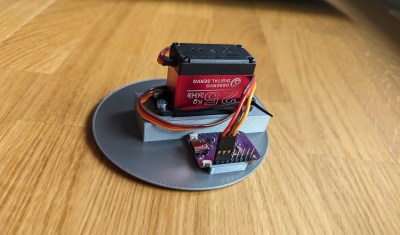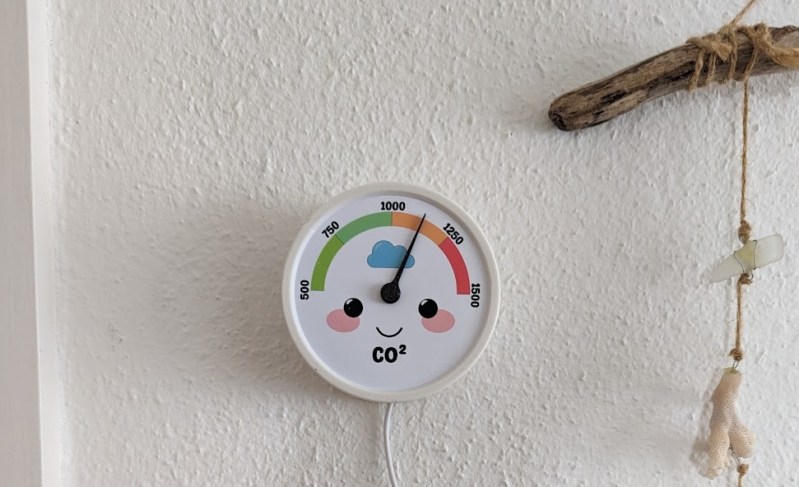[Cyrill] has a good home automation scheme going: there are a number of physical switches set around the place that control the essential functions. The only problem is that in the winter time, this results in a great deal of phone checking as [Cyrill] tries to monitor the CO2 level. Tired of all this screen time, [Cyrill] set about to create an incredibly cute (and useful) Co2 monitor that plainly shows the current level and how bad it is, relatively speaking.

Behind that adorable face is a DS3225 servo being driven by a Wemos S2 mini, both of which [Cyrill] happened to have handy. Although the 25 Kg servo may be complete overkill for the situation, [Cyrill] reports that it is quieter than your average AliExpress alternatives, which makes it well worth it in our book. Then it was on to Inkscape to make the gauge itself. [Cyrill] says they’re an Inkscape noob, but that face could have fooled us.
Finally, it was time to integrate it into Home Assistant to get readings from the CO2 sensors. This was easier said than done, but [Cyrill] does a nice job of explaining how to get the ESP32-S2 up and working.
If you’re out there monitoring CO levels in your home, beware of fake sensors that cropped up during the height of the pandemic and are likely still at large.















Very nice, but random noise will drive you nuts during the night.
I would use a cheap galvometer/voltmeter, driven by a simple analog/pwm_Write()
I like having dedicated function gauges for critical measurements. If I had a CO2 sensor, I’d probably do something like this (with less artistic flair because skills).
That dial face wants to have an epaper display embedded to change the smile to a frown when the CO2 goes high.
(I predict that the superscript 2 is going to drive some chemist reader bonkers)
Prediction validated . . . should be a subscript.
But I’m more worried about the typo f you’re out there monitoring CO levels in your home If you have CO levels — you’re dead.
I mean, you can absolutely monitor CO levels if you have a fireplace or something and want to know that you’re not exposing yourself to more than it’s worth just for a pretty fire. If the levels ever go beyond a certain amount, it should alarm and you should take that as an indication to douse the source, ventilate, and spend some time outside. Change the order of operations around depending on whether the levels are acutely dangerous or just too high for continuous habitation.
That’s probably what it says in footnote 2.
Just to clarify: the servo doesn’t _mass_ 25kg. It has a torque of 25 kg cm. Both the label on the side of the servo and the way it’s described in the article is wrong.
Well, I mean, that’s a given.
Are you trying to say: “all hackaday articles are wrong, but some are useful”?
Especially wrong because kg.cm is not even a unit of torque. You’ll never see a torque wrench calibrated with that unit.
Closest real unit might be newton-centimeters, N.cm.
And it’s a fake spec anyway: The actual rated torque for these “25 KG[sic]” RC servos is actually 0.6 to 0.8 N.m, (7 to 8 “KG”), one third of the torque you might infer from the big lettering on the side.
The “25” rating is the torque where it will fail to function, and fail permanently if driven that hard for very long — its temperature rise rate will cause an overheat in a few minutes at most.
That’s true, but that’s also false : servos for remote controls models have been rated in kg/cm for ages (at least I can remember that from the 90′), and every modeler knows what it means, and choose them accordingly for their models.
So where is XP on this scale?
In submarines, higher CO2 concentrations are permitted, usually 5000- 7000 ppm. i.e. In a high performance warfighting environment they don’t start worrying about CO2 levels until they hit 7000 ppm. An O2 meter is far more important as your body can’t detect O2 levels, but you can sense CO2 levels. Furthermore all of these cheap sensors have a short lifespan and dubious quality too, so you’d be better off building a Heat Recovery Ventilation Unit with added electrostatic, hepa, and activated carbon filtering stages so that you have a continuous supply of fresh air.
What sensor is used? Couldn’t find the info. It’s all about the servo. Car gauge X27.168 steppers could work here too.
Modern HVAC throttles fresh air intake based on CO2. It’s expensive to heat/cool outside air, as opposed to recirc. So at a mall or work, you’re in a high CO2 environment based on min. heating/cooling cost. Sad.
” So at a mall or work, you’re in a high CO2 environment ” That’s simply not true. ALL types of large places pull air from outside. Why do you think the filters are on the roof?
Like I said, it costs money to heat/cool outside air in big buildings. There are modulating dampers on fresh air keeping it around 800-1200ppm. Also, you don’t want excessive positive pressure in a building, so not like you say lots of fresh air pumped in. CO2 also tells you if a building is occupied.
My point again, CO2 control of HVAC in large buildings is commonplace. How accurate is the sensing and algo?
https://www.co2meter.com/en-ca/blogs/news/co2-sensors-hvac-energy-efficiency
https://youngregulator.com/wp-content/uploads/2020/08/demand-air-iom-ver-1.0.pdf
https://www.networkthermostat.com/news/use-co2-sensor-maintain-fresh-air-buildings
Lab grade sealed home or a wood stove that leaks, I’d think. Most of us thankfully are in neither space.
I was thinking of the face, “cheeks” would turn blue and the “brain” would turn black when in the red.
You have larger problems if you need to watch your CO2 levels. maybe you should check your heat exchanger and see if its cracked.
Yes, this. We don’t know why he has to monitor CO2, but if he has, it’s not for good reasons, he shoud probably check his heating.
Another note, it would be useful and easy to add audio alarm to this. He already has sensor and controller, he just needs to add a beeper and few lines of code.
In any well insulated and hence also rather airtight apartment, without HVAC system, you easily reach the > 1500 ppm level by just breathing.
Ok, yah. Came to ask.. Is high CO2 in the home a common problem that people worry about? I’ve never heard of this. What are people doing?
Living in submarines?
Factory sized beer brewing in a studio apartment?
At first I assumed it was a typo and CO was intended.
Or maybe you live in a newer well-sealed home or small apartment but still have a gas stove, or something. Or maybe sometimes you have two people and some candles in an enclosed room and want a reason not to worry about the air quality. Or maybe you use CO2 as a proxy variable, since high levels generally indicate that there has not been much ventilation, even if the reason the air is stuffy may not be just the CO2.
You´re all wrong, it´s a post-COVID stigma that sticks. CO2 sensors spread in all meeting rooms that I know at work, people notice the visual indication, then open the windows for a bit of fresh air.
This
There is a lot of confusion here, even in the HaD article. PLEASE don’t confuse CO (carbon MONoxide) and CO2 (carbon DIoxide).
The first one is HIGHLY TOXIC and – worse – you can’t sense it. It can easely kill you if your gas heater has a problem or – !!!DO NOT DO THIS!!! – you are making barbecue inside your house. CO is relatively easy to measure as it is a reactive gas (it can burn), but as this is a highly safety critical application i strongly recommand getting a industrial made, certified CO detector (not to be confused with a smoke detector although SOME of them are dual function smoke+CO). Here in Europe its maybe 30-50€ depending on brand, … DO NOT buy no-name crap from Aliexpress!!! It may work or you may pay A LOT more == your life if something goes wrong and the damn thing does not alert you.
Now to CO2: This stuff is what you breath out and what is a big problem for climate change. You CAN sense it, if CO2 levels are to high you will not feel well. So personnally i am not convinced it is needed to monitor this (in a “normal” household environnment!). During the pandemic it was often monitored in places like schools but only as an indicator high CO2 == we need to ventilate to limit the exposure *to the Covid-virus* (or other viruses and nasty stuff).
A word of caution: Cheap sensors often give you eCO2, that is *equivalent* CO2, based on – iirc – hydrogene level and some more or less clever algorithm. In my (limited) experience these (the CCS811 was a well known sensor of this type) are mostly crap. DO NOT use them to monitor CO2 in places where you make beer or have bottles of CO2 stored as these will NOT react to “real” CO2 as i said. Real sensors for CO2 are not cheap and use highly complex physics (maybe write an HaD article about that?), some infrared-magic-stuff or something… Sensirion makes fine ones like the SCD40, but they are not cheap and really small and – i guess – can only be soldered without damage with a real reflow oven with controlled temperature profile, so you better get a breakout board.
HTH.